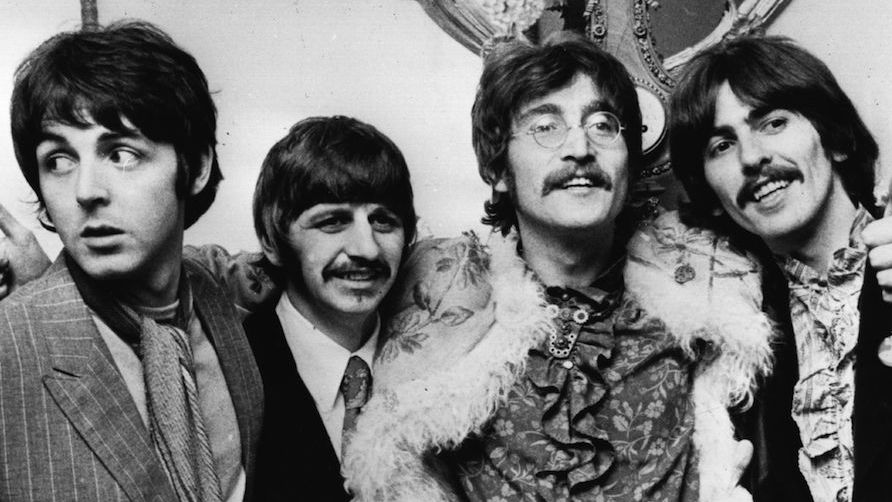The Beatles’ decision to stop touring, taken after their US jaunt in the summer of 1966, allowed them the opportunity to immerse themselves in the studio and focus on songwriting. It was a period that produced their greatest and most innovative work, beginning with Revolver and ending three years later with Abbey Road (although Let It Be, recorded earlier, didn’t surface until after they’d split in 1970). Naturally, this threw up a tidy pile of less-celebrated gems…
10) Savoy Truffle (The Beatles, 1968)
Often dismissed as one of the White Album’s more nonsensical offerings, largely due to lyrics inspired by George Harrison’s good friend Eric Clapton and his appetite for Mackintosh’s Good News chocolates, Savoy Truffle is, in fact, a superior blues-rock tune that highlights Harrison’s growing maturity as a songwriter. It’s also notable for a terrific horn section.
9) Don’t Let Me Down (b-side of Get Back, 1969)
John Lennon rarely sounded more impassioned with The Beatles, his raw vocal freighted with desperation as he pledges devotion to Yoko: ‘I’m in love for the first time / Don’t you know it’s gonna last…’ The tone of the message is offset by a relatively becalmed musical setting, a soulful purr that features Billy Preston on piano.
8) The End (Abbey Road, 1969)
The last song recorded by all four Beatles, The End serves as delicious coda to the medley that dominates the second side of Abbey Road. Fittingly, each member takes a solo, before a brief piano melody makes way for strings and a celestial harmony asserting that, in the final reckoning, ‘the love you take is equal to the love you make’.
7) Baby, You’re A Rich Man (b-side of All You Need Is Love, 1967)
Initially earmarked for the Yellow Submarine film, this genuine Lennon and McCartney collaboration fuses components from two unfinished songs into a psychedelic nugget with a bluff chorus. Studio effects abound, from feedback delay to the slightly disorientating use of a clavioline, an early type of synthesiser. Rumour has it that Mick Jagger sings backing vocals at the end.
6) She’s Leaving Home (Sgt. Pepper’s Lonely Hearts Club Band, 1967)
This baroque pop masterclass highlights Paul McCartney’s ability to craft a heart-wrenching lyric, inspired by a Daily Mirror story about a teenage runaway. “She slips out and leaves a note and then the parents wake up,” he explained. “It was rather poignant.” In the absence of George Martin, McCartney commandeered string arranger Mike Leander to rouse a mini-orchestra.
5) The Inner Light (b-side of Lady Madonna, 1968)
The last and best of three Indian-flavoured Harrison tunes (after Love You To and Within You Without You), The Inner Light finds him espousing the virtues of Transcendental Meditation. Based on a poem from the Taoist Tao Te Ching, it boasts a sublime melody and a variety of instrumental exotica – sarod, shehnai and pakhavaj – from a crack team of Indian players.
- The top 10 best Beatles songs written by George Harrison
- 10 Things We Learned Watching The New Version Of The Beatles At Shea Stadium
- Buyer's Guide: George Martin – the legendary producer of The Beatles and more...
- Tape decks, drugs and Abbey Road: how The Beatles’ Revolver revolutionised rock
4) Happiness Is A Warm Gun (The Beatles, 1968)
Inspired by the headline from a firearms magazine that George Martin had shown him, Lennon’s mini-suite somehow manages to compress the evolution of rock‘n’roll into less than three minutes. The song flips moods between balletic acid-pop, garagey fuzz and doo-wop, made memorable by the repeated mantra: ‘Mother Superior jump the gun.’
3) She Said She Said (Revolver, 1966)
An acid-fuelled party in Beverly Hills, during which actor Peter Fonda kept bringing everybody down with the phrase “I know what it’s like to be dead”, provided the impetus for John Lennon’s suitably lysergic meditation on the spiritual quest. Driven by George Harrison’s piercing guitar, it’s also made distinctive by Ringo Starr’s circular drum figures.
2) Rain (b-side of Paperback Writer, 1966)
Hallucinatory Lennon lyrics, distorted guitars, an insistent bass groove and one of Ringo’s tricksiest drum patterns, Rain is a prime example of The Beatles as a formidable entity. Issued two months before Revolver, its pioneering use of backwards vocals, mutable tempos and faded effects set a precedent for the likes of Tomorrow Never Knows and Strawberry Fields Forever.
1) Hey Bulldog (Yellow Submarine, 1969)
Led by Lennon’s great piano riff, this saving grace from the Yellow Submarine soundtrack features a waspish Harrison solo (courtesy of a new fuzz box) and a McCartney bassline that engineer Geoff Emerick declared “probably the most inventive of any he’d done since Sgt. Pepper”. Later covered by everyone from Alice Cooper and Fanny to Ween and Dave Grohl, this is The Beatles at full tilt.

